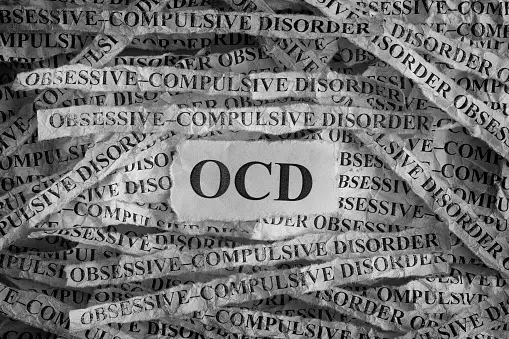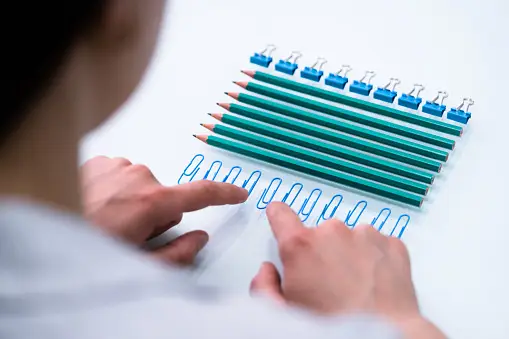OCD, or Obsessive-compulsive disorder, is a type of mental illness (anxiety disorder) characterized by repeated obsessions (undesired thoughts, sensations, or images) that provoke anxiety. A person with OCD does repetitive tasks to overcome anxiety and distress, known as compulsions.1Brock, H., & Hany, M. (2022, August 15). Obsessive-Compulsive Disorder. Nih.gov; StatPearls Publishing.

https://www.ncbi.nlm.nih.gov/books/NBK553162/
For example, If a person is obsessed with being contaminated by using or touching public toilets, he washes his hands repeatedly to overcome his anxiety. This is a vicious cycle of OCD. Some people have only one of these two, and some have both. Compulsions are more easily diagnosed than an obsession because compulsions can easily be observed. Symptoms of OCD are static in some adults and variable in children.
Incidence Of OCD
According to the National comorbidity survey replication(NCS-R). About 1.2% of United States adults had this chronic disorder in the past year. Males are more commonly affected in childhood than females, while the reverse pattern is observed among adults. According to recent statistics, the ratio of OCD is higher in female adults than in males. It is about 1.8% in females and 0.5% in males. The overall prevalence of OCD in the US is approximately 2.3% of the population. 2Obsessive-Compulsive Disorder (OCD). (2017). National Institute of Mental Health (NIMH). https://www.nimh.nih.gov/health/statistics/obsessive-compulsive-disorder-ocd#:~:text=Prevalence%20of%20Obsessive%2DCompulsive%20Disorder%20Among%20Adults,-Based%20on%20diagnostic&text=An%20estimated%201.2%25%20of%20U.S.,OCD%20in%20the%20past%20year
The mean age for the onset of OCD is around 19.5 years. In 25% of people with OCD, its symptoms are observed at the age of 14 years. It rarely occurs after 35 years of age.

Types Of OCD
There are multiple types of OCD, including contamination OCD, checking OCD, harm, symmetry, postpartum OCD, rumination, and just right OCD. 3Guazzini, A., Gursesli, M. C., Serritella, E., Tani, M., & Duradoni, M. (2022). Obsessive-Compulsive Disorder (OCD) Types and Social Media: Are Social Media Important and Impactful for OCD People? European Journal of investigation in Health, psychology, and Education, 12(8), 1108–1120. https://doi.org/10.3390/ejihpe12080078 Let’s discuss each type of obsessive-compulsive disorder:
Contamination OCD:
It is the most common type of OCD. Contamination OCD is characterized by fearing being contaminated by germs or micrograms and getting ill. A person with contamination OCD always feels like he has dirty hands, feet, or body. To overcome this anxiety, he washes his hands and takes a shower, again and again, to make himself clean and germ-free. He avoids sticky substances like glue, dirt, or grease. He also fears coughing and sneezing in crowded and public places.
Checking OCD:
Checking is a subtype of OCD in which the person has a ‘checking compulsion’ to avoid a bad incident. He has an insecurity that he will forget something which will be harmful. To overcome his anxiety, he repeatedly checks everything to ensure nothing is unsafe. Common examples of checking OCD are:
- Checking door locks to ensure they are locked or unlocked and wallet to see if credentials and money are safe.
- Checking stoves to make sure that they are burned off. Checking lights to make sure they are switched off.
- Constantly fearing that he has not done his task, and possesses repetitive behavior to reassure himself.
- Always rushing to the car to make sure it is locked.
Harm OCD:
Harm OCD is a subset of obsessive-compulsive disorder characterized by having aggressive and intrusive thoughts of violence and harming others. People with harm OCD fear losing control over themselves and being violent to others. They always have unpleasant and intrusive thoughts leading to guilty and crushing anxiety.
Symmetry OCD:
Symmetry OCD falls in the category of just right OCD or perfectionism. In this type of OCD, the person is conscious of symmetry, patterns, and orderliness. People with this condition feel a strong compulsion to arrange and align things perfectly and ensure that everything is in a particular order. He feels uncomfortable and distressful when he comes across imperfectly shaped things. He does time-consuming and purposeless activities in organizing different items to relieve his anxiety.
Symmetry OCD may seem like a harmless quirk, but it can be extremely distressing for those who suffer from it. Symmetry OCD can lead to other mental health issues if left untreated.
Rumination OCD:
Rumination OCD is a type of obsessive-compulsive disorder in which certain thoughts get fixed in a person’s mind. These are usually negative thoughts and are difficult to debunk. This type of OCD can lead to severe distress and anxiety, interfering with routine activities. Repetitive and intrusive thoughts, compulsive mental reviewing, and excessive self-blame often characterize Rumination OCD.
The person wastes most time reviewing and overanalyzing certain questions, thoughts, and themes.
Just right OCD:
It is a type of OCD in which the person feels uncomfortable about things being wrong. In response, a person with just the right OCD performs multiple tasks to subside his discomfort.
Postpartum OCD:
Postpartum OCD, also known as postpartum obsessive-compulsive disorder, is a common mental health issue among new mothers. It is characterized by intrusive, repetitive, and unwanted thoughts or fears about the baby’s safety or well-being. These thoughts can lead to severe anxiety. Mothers with postpartum OCD have compulsive behavior. The most common repetitive tasks are related to cleaning, checking, and counting. These include:
- Fearing contamination with germs and cleaning the baby repetitively.
- Constantly checking if the baby is breathing and if the monitor is working properly.
- Cleaning baby bottles again and again
It should be treated as early as possible to ensure the safety of the mother and baby.
Causes and Risk Factors of Different Types of OCD
The cause of OCD is still unknown, but many studies believe it might have a genetic predisposition. Some risk factors can aggravate OCD. 4Stein, D. J., Costa, D. L. C., Lochner, C., Miguel, E. C., Reddy, Y. C. J., Shavitt, R. G., van den Heuvel, O. A., & Simpson, H. B. (2019). Obsessive-compulsive disorder. Nature reviews. Disease primers, 5(1), 52. https://doi.org/10.1038/s41572-019-0102-3 These factors include:
- Positive family history of OCD
- Depression
- Anxiety
- Mental abnormality
- Previous trauma
- History of physical or sexual abuse
- Infections (streptococcal infection characterized by pediatric autoimmune neuropsychiatric disorder)
The rate of OCD is higher if 1st-degree relatives had OCD in their childhood than in 2nd-degree relatives. The overall rate of OCD is higher in monozygotic twins than in dizygotic twins. Dysfunction in the following brain areas also causes OCD:
- Anterior cingulate cortex
- Orbitofrontal cortex
- Striatum
Signs & Symptoms of Different Types of OCD
Symptoms of OCD are most commonly seen in adults. OCD is more prevalent in females than males. Signs and symptoms of obsessive-compulsive disorder include obsessions and compulsions.
Obsessive Symptoms:
Obsessive symptoms include:
- Fear of being contaminated
- Fear of making mistakes
- Organization and perfection
- Fear of causing harm to yourself or your loved ones
- Unwanted thoughts
- Aggression and images related to sex
- Self-doubt and guilty
- Religious obsessions
Symptoms of obsession vary in children and adults. Religious obsession and sexual aggression are more common in adults, but harm obsession is more common in children.
Compulsive Symptoms:
Compulsion is a set of activities that are performed to minimize anxiety. Its symptoms include:
- Washing, showering, and cleaning again and again
- Arranging things
- Turning on and off the lights again and again
- Collecting the valueless items
- Brief and repetitive movements of the eye( blinking), shrugging, and head jerking (also known as OCD tics). Up to 30 percent of individuals have this disorder.
- Saying strange words
- Repeatedly checking things for reassurance
- Orderliness
- Constant reassurance
-

A woman washing hands again and again due to OCD
Functional Effects of Different Types of OCD
People suffering from OCD have social and occupational impairments. It also affects other aspects of life depending on the duration and severity of the disease. OCD in childhood or school-going age can cause developmental abnormalities. Other effects of OCD are:
- Skin lesions due to excessive washing
- Family dysfunction
- Impaired relationships
- Financial instability
- Suicidal thoughts
- Poor concentration and interest in studies
When to See Your Doctor?
Immediately book an appointment with your doctor if your obsessive and compulsive behavior interferes with your life and social activities. Suicidal and intrusive thoughts are warning signs of obsessive-compulsive disorder.
How To Diagnose Different Types of OCD?
There are no specific tests to diagnose OCD. Doctors can diagnose it clinically by asking certain questions. They assess the disease’s severity by using Yale-Brown obsessive-compulsive scale (Y-BOCS). This method rates OCD on a scale of 0-40, according to the severity of the disease. The following is a criterion to diagnose OCD:
About Obsession:
- How much time do you spend on your obsessive thoughts?
- Do your obsessions interfere with your daily life activity? If yes, then how much?
- Do your obsessive thoughts cause anxiety? If yes, then how much?
- Do you resist your obsession?
- Do you have control over your obsessive thoughts? If yes, then how much?
About Compulsions:
- How much time do you spend on doing tasks to relax?
- Does your compulsive behavior interfere with your life routine? If yes, then how much?
- Do you feel anxious if you prevent yourself from doing compulsive behavior?
- Do you resist your compulsive behavior?
- Do you have control over your compulsive behavior? If yes, then how much?
Some laboratory tests are done to rule out the other diseases:
- CBC
- Thyroid profile
- Liver functions test
- Renal function test
Treatment of Different Types of OCD
The following therapies treat obsessive-compulsive disorder:
- Medical therapy
- Cognitive behavioral therapy ( CBT)
- Exposure-response prevention therapy ( ERPT)
- Neuromodulation (Deep brain stimulation)
Medical Therapy:
Your doctor may start your treatment for OCD with Selective Serotonin reuptake inhibitors (SSRIs). They are the mainstay of treatment. The Food and Drug Administration(FDA) has approved some drugs of this class. These medications include sertraline, fluoxetine, paroxetine, and fluvoxamine.
Traditionally, doctors used to treat types of OCD with tricyclic antidepressants (like clomipramine). Tricyclic antidepressants are not a treatment of choice nowadays due to their adverse effects.
Other medications like tramadol, ondansetron, and amphetamine are helpful in augmentation therapy in treating OCD.
Exposure-Response Prevention Therapy:
It is a type of therapy in which your psychiatrist exposes you to your fears. Step-by-step desensitization helps overcome compulsions. For example, your doctor may ask you to live in a room with unarranged and scattered things. Don’t try to arrange anything and overcome this compulsion step by step. Exposure response prevention therapy restructures your mind and alters your habits.
Cognitive Behavioral Therapy:
Cognitive behavioral therapy (CBT) consists of psychological interventions. CBT helps overcome your anxiety-provoking thoughts. It is a specialized treatment approach that changes the way you think and do. With the help of CBT, your doctor may help you cope with problematic thoughts. Family counseling is also helpful.
Deep Brain Stimulation:
Deep brain stimulation is a minimally invasive surgical procedure preferred for patients who fail to respond to medical treatment. It is helpful for treatment-resistant obsessive-compulsive disorder. Deep brain stimulation can alleviate OCD symptoms in 60% of patients. It is an FDA-approved treatment for treatment-resistant OCD. Although deep brain stimulation is an effective procedure, it is rarely used as it is invasive and costly.
Follow up :
A regular follow-up is essential to treat OCD and its complications. If you have OCD, address troublesome complications of OCD as soon as possible.
What is the Difference Between OCD and OCPD (OCD vs. OCPD)?
OCD is a mental illness; its symptoms are unwanted anxiety-provoking thoughts leading to repetitive tasks. It consists of compulsions and obsessions. On the other hand, OCPD is a personality disorder in which there is no obsession or compulsion and the feeling that the person is in control. In OCPD, the person has a fixed behavior to ensure orderliness, neatness, mannerism, and perfection. He strongly urges to impose his own standards of perfectionism on others. People with OCPD have rigid behavior, punctuality, and compliance with rules and regulations. They devote their lives to work.
Can you Prevent OCD?
No, there is no way to prevent any type of OCD. Early diagnosis and treatment can reduce the duration and severity of the disease. You must consult a psychiatrist as soon as possible for the treatment of OCD before it starts affecting your life.
What Triggers Different Types of OCD?
Anxiety, emotional or physical stress, childhood trauma, traumatic events, and sudden environmental changes usually trigger OCD. Poor sleep and drinking alcohol can also trigger any type of OCD. Getting quality sleep, mindfulness, meditation and relaxation techniques, and avoiding alcohol, smoking, and nicotine can help with obsessive-compulsive disorder.
Conclusion
OCD is a chronic disease characterized by purposeless thoughts that leads to anxiety and compulsive tasks to avoid anxiety. Diagnosis of types of OCD is based on history and physical and clinical evaluation. It is better to diagnose and treat OCD in the early stages to minimize the duration and severity of the disease. If you have symptoms of OCD, immediately consult your doctor for further evaluation, diagnosis, and treatment.
Refrences
- 1Brock, H., & Hany, M. (2022, August 15). Obsessive-Compulsive Disorder. Nih.gov; StatPearls Publishing.

https://www.ncbi.nlm.nih.gov/books/NBK553162/ - 2Obsessive-Compulsive Disorder (OCD). (2017). National Institute of Mental Health (NIMH). https://www.nimh.nih.gov/health/statistics/obsessive-compulsive-disorder-ocd#:~:text=Prevalence%20of%20Obsessive%2DCompulsive%20Disorder%20Among%20Adults,-Based%20on%20diagnostic&text=An%20estimated%201.2%25%20of%20U.S.,OCD%20in%20the%20past%20year
- 3Guazzini, A., Gursesli, M. C., Serritella, E., Tani, M., & Duradoni, M. (2022). Obsessive-Compulsive Disorder (OCD) Types and Social Media: Are Social Media Important and Impactful for OCD People? European Journal of investigation in Health, psychology, and Education, 12(8), 1108–1120. https://doi.org/10.3390/ejihpe12080078
- 4Stein, D. J., Costa, D. L. C., Lochner, C., Miguel, E. C., Reddy, Y. C. J., Shavitt, R. G., van den Heuvel, O. A., & Simpson, H. B. (2019). Obsessive-compulsive disorder. Nature reviews. Disease primers, 5(1), 52. https://doi.org/10.1038/s41572-019-0102-3

